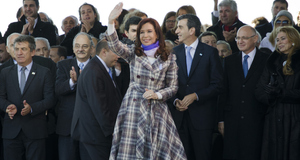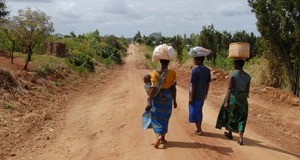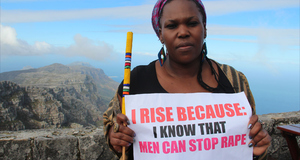Featured Article:Gender Equality in International Institutions: Progress and Challenges in Moving Toward Gender Parity
By
2017, Vol. 9 No. 02 | pg. 2/2 | « Gender and Transitional JusticeThe lack of female forces in NATO and UN peacekeeping means more than a lack of representation. With the case of the UN, it appears that gender norms supporting equality and gender-sensitive justice have not been instilled in the male peacekeepers in charge of ensuring the transitional justice process in areas where sexual violence has been endemic. Because peacekeeping in these areas was not envisioned to be permanent, legal immunity from state prosecution for crimes for peacekeepers was not thought of as problematic; specifically, the 1990 Model Status of Forces Agreement states, in Article 46, that “all UN peacekeeping personnel are immune from legal process in respect to acts they perform in their official capacity” (Tate, p. 69). However, in 1994, incidents of sexual exploitation and abuse by peacekeepers in Somalia and Cambodia were reported to the media. Reacting to these reports, the Special Representative of the UN Secretary-General in Cambodia, said four telling words: “Boys will be boys” (p. 70). In 2001, reports commissioned by the UN High Commissioner for Refugees emerged that UN peacekeepers had sexually abused refugees in Guinea, Liberia, and Sierra Leone – areas that they had been mandated to protect from human rights violations - - in a Subsequent reports in 2004 and 2005 showed an increasing number of incidents of sexual exploitation and abuse, despite special measures that were introduced after the 2001 report to protect civilians from sexual exploitation and abuse. In 2005, the Zeid Report was released, which proposed a prevention strategy to eliminate sexual abuse in future peacekeeping missions; however, Tate writes that “the question remains how far these preventative strategies, awareness campaigns, and changes in the legal framework have genuinely achieved a significant shift in attitudes and practices amongst peacekeepers” (Tate, p. 71). Tate finds that the lack of attention historically paid to sexual abuse in peacekeeping relates to the military culture that UN peacekeepers, predominantly male, have traditionally come from prioritizes the protection of masculine military cultures over the protection of women and children, and that “there is concern over the extent to which a masculine culture within the UN itself continues to affect its will to deal with this problem transparently” (p. 74). Tate furthermore notes that, despite the mandates of UNSCR 1325 are problematic because their violation, by member states or by the UN itself, are not legally binding, and there is no monitoring or enforcement mechanism in place to ensure their implementation.In 2005, the UN introduced Troop Conduct and Discipline Units, intended to collect data on allegations of misconduct, and determine whether a further formal legal investigation is required. Conduct and Discipline Teams are furthermore dispatched to train peacekeepers on gender balance and human rights and conduct sexual exploitation educational prevention and “awareness campaigns” in targeted mission zone territories. Tate notes that “these educational prevention strategies rely on traditional information-based awareness platforms such as training seminars and manuals in order to communicate educational information to a passive target audience” (p. 72). However, there is little evidence that this gender awareness campaigns bring about consistent behavioral change for peacekeepers. Tate writes that psychological studies have shown that “asking people to change their behavior has little impact; it overlooks the broader social context of masculine and feminine identities, which makes the negotiation of behavior change a complex process” (p. 72). The 2003 Secretary-General’s Bulletin defined sexual abuse and exploitation, and set forth a zero-tolerance policy of a range of prohibited conduct, including trafficking, child pornography, prostitute solicitation, sex with minors. In addition, sexual relationships between peacekeepers and “beneficiaries of assistance” are not prohibited but are “strongly discouraged.” Feminist scholars were quick to criticize the language of the Bulletin as reinforcing stereotypes of ‘typical’ masculine behavior in military culture, writing that “the UN’s rhetoric confirms that an innate male predisposition to sexual violence exists” (Tate, p. 73). They also note that it denies the socioeconomic and structural realities that women deal with in post-conflict territories characterized by collapsed economies, weak judicial systems, and weak and ineffective law enforcement agencies. and the inherent sociocultural norms of the transitioning society that keep women in unequal and vulnerable positions to begin with. Women may be forced by poverty to to prostitute themselves or enter into relationships where they might be ‘beneficiaries of assistance’, which, by being ‘strongly discouraged’ and not expressly prohibited by the UN, invoke senior UN officials to determine whether these relationships are exploitative, and thus make a judgment call. Furthermore, Tate writes that, by failing to equating every form of sexual abuse as being equal in degree, and failing to differentiate between commercial prostitution and rape, the Bulletin leaves open the discretion to the peacekeeper to determine the severity of the action, potentially trivializing it. Furthermore, by making sexual misconduct a disciplinary issue and not a criminal issue, the UN Bulletin leaves the prosecution of the offender open to the discretion of the state in which the offense occurs. A case of this failure of accountability happened in the Czech Republic to an American female peacekeeper who was raped by two Czech peacekeepers. The Czech court found that, because the victim had had consensual sex with one of the two accused on a previous occasion, she must have consented to the entire incident. Tate writes, “this implies that the Czech criminal court culture promotes a conception that where an individual has previously consented to sex with an individual, she is likely to always consent to sex where the same individual is involved” (p. 74). It is easy to see how letting the transitioning territory have jurisdiction, particularly when they are in transition post-conflict and thus without the full legal resources or mechanisms of enforcement, that peacekeeper misconduct would fall through the cracks. Tate also notes that disturbingly, in some jurisdictions, some countries do not prosecute sexual violence if the offender marries their victim; this appears to be a particular problem for UN peacekeepers, as they “frequently marry their victims” (p. 75). Besides the obvious undermining of human rights protection and eroding of the overall trust in the UN of the peacekeeping mandate, Tate writes that “this in turn promotes the value of predominantly masculine human rights over those of women and girls, undermining the likelihood that the solution can be found in the national civilian courts” (p. 75). In addition to the failure to protect the civilian populations from its own peacekeepers, the UN has been accused of, while formally acknowledging the importance of involving women in post-conflict reconstruction, failing to do so in practice, when informal gender norms undermine the formal rule in place. An example of this exclusion is in the gender justice gaps evident in the post-conflict reconstruction of Bosnia-Herzegovina. Bosnia-Herzegovina was the first country in eastern Europe to adopt a National Action Plan for the implementation of UNSCR 1325. Bjorkdahl and Selimovic write that, despite having institutional mechanisms for gender mainstreaming in place from the beginning, and a Gender Equality Agency to push gender awareness in Bosnia-Herzogovina, the post-conflict transition has not been gender-sensitive, and that the high levels of sexual violence today in Bosnia-Herzegovina indicate that the attention that the ICTY drew to sexual violence did not have a lasting impact, and women’s rights guaranteed by law have not been fully respected. “Lack of political will” (p. 208) has commonly been cited as the reason for the lack of full implementation of gender-sensitive processes. A conservative backlash has also come about post-conflict, that re-institutionalized old traditional gender roles. Furthermore, as the domestic legal system in Bosnia-Herzegovina has taken over the post-war accountability process as the proceedings of the ICTY come to a close, the legal framework has not been consistent with the rules adopted by the ICTY, and prosecutions have been few and far between. Processes in place for witness protection have beem “marginal at best,” with victims having to share waiting rooms in some cases with defendants, and their identities leaked to the press, in violation of the norms established by the ICTY. Bosnian women have also been marginalized economically in the transitional system, and in the design and implementation of the reparations program. Bjorkdahl and Selimovic observed a “gendered reparations gap,” in which the distinction between perpetrators and victims is politically contested and divided along ethnic lines, making it difficult for victims to come together as reparations advocates. Christine Bell’s tripartite framework of peacemaking identifies “substantial barriers and pitfalls for women’s participation and substantive take-up of the issues that most substantively affect them” (Ni Aolain, p. 1073, citing Bell, 2000, p. 100). Furthermore, the military decisionmaking that takes place post-conflict, which is inherently and exclusively male-dominated, excludes their input as civilians. Disarmament, demobilization, and reintegration (DDR) programs are an inherent part of the peacemaking process which often fail to take into account the effect that disarmament has on women’s security – for example, the reintegration of demobilized soldiers into society when they have harmed women during conflict - because gender concerns are sidelined as a “special attention” but not mainstreamed in DDR policy. The process of peacemaking furthermore involves compromises that, if women are not included at the negotiating table, may include concessions on the safety and security of women and fail to acknowledge their particular vulnerabilities. Ni Aoilain writes that “an important general element to consider here is whether the bureaucratic, command control-oriented, masculine systems and structures which pervade the international community’s interface with domestic security systems are actually structurally capable of accommodating change” (p. 1078). But how do deeply entrenched institutional norms change? Chappell (2006) writes that “institutional change comes about through an incremental or evolutionary process” (p. 230, citing Campbell, 2005, p, 58) through soft spots or gaps that can occur in interpretation and enforcement, rendering it ambiguous. Institutional change must also be negotiated and is often the result of political compromise. Waylen (2013) that, with regard to other institutional norms, displacement of the norm – replacement of the old rules with new ones – may occur, but not in the case of gender norms because “it relies on the absence of a strong veto” and “gender equity actors rarely have sufficient power so the opportunity to achieve wholesale displacement” (p. 218). An example is the U.S. military rule barring females from combat situations, which has been informally violated and, within the last two weeks, formally changed. Due to the increasing involvement of women in combat-related activities in Iraq and Afghanistan as Female Engagement Teams, from which they were legally prohibited, the Pentagon announced on December 3, 2015 that women could now serve in front-line ground combat positions, on Special Forces teams and other elite units, and that all positions they were previously legally prohibited from serving in would now be open to them. Defense Secretary Carter, in the announcement, noted that the military will have to now “dispel the idea,” held by some in their ranks, that women might be included in their units for any reasons other than their qualifications. Yet, almost as soon as this policy was announced, the backlash from the military began. The Marine Corps released a study ostensibly showing that all-male units were more effective in combat than mixed gender units. Answers to questions posed to male Special Forces members about the new policy reveal just how deeply gender norms, despite women being allowed to serve since 1976, when the first class of women was admitted to the military academies, gender norms and stereotypes about the capabilities of women are still difficult to overcome. One member commented, “women take time in the shower. It breeds dissension,” while another expressed concerns that PMS would heighten women’s emotions on the battlefield, because, when his wife gets PMS, “she’s weaker.” However, obtaining a combat position is also linked to being promoted to higher positions in the military, and thus women’s visibility in high-levels of military leadership could slowly change the perception of women in the military and make incremental steps at changing the institutional norms. On December 16, West Point announced the selection of Brigadier General Diana Holland, a veteran of both Iraq wars and Afghanistan, to the position of Commandant of U.S. Corps of Cadets, the first female in this position ever. Overall, the presence of women as capable leaders in combat missions may have to reach “critical mass” before perceptions of their status as equals change. ConclusionInternational institutions must recognize that gender equality doesn’t come about simply by issuing resolutions and creating mandates, and that equality isn’t just important for civilians in the countries that these institutions ostensibly propose to help. In order for perspectives to change and informal and formal institutional rules to complement one another, international institutions need to recognize their own role in upholding gender inequalities within their organizations and structures, and gender parity, free of norms and assumptions about the jobs and roles that women should occupy, and with the full support of the institutions, needs to be achieved, so that gender mainstreamed policies can truly be effective and increase global gender equality. ReferencesAskin, K.D. (1999). Sexual Violence in Decisions and Indictments of the Yugoslav and Rwandan Tribunals: Current Status. The American Journal of International Law, 93(1), 97-123. Baldwin, J.N. (1996). Female Promotions in Male-Dominant Organizations: The Case of the United States Military. The Journal of Politics, 58(4), 1184-97. Bjorkdahl, A., Selimovic, J.M. (2014). Gendered Justice Gaps in Bosnia-Herzegovina, Human Rights Review, 15, 201-218. Bleckner, J. (2013). From Rhetoric to Reality: A Pragmatic Analysis of the Integration of Women into UN Peacekeeping Operations. Journal of International Peacekeeping, 17, 337-360. Byrne, S. (2012). Gender, Representation and Power-Sharing in Post-Conflict Institutions. International Peacekeeping, 19(5), 565-580. Campbell, K. (2007). The Gender of Transitional Justice: Law, Sexual Violence and the International Criminal Tribunal for the Former Yugoslavia. The International Journal of Transitional Justice, 1, 411-432. Chappell, B. (2015, December 3). Pentagon Says Women Can Now Serve In Front-Line Ground Combat Positions. NPR. Retrieved from http://www.npr.org/sections/thetwo-way/2015/12/03/458319524/pentagon-will-allow-women-in-frontline-ground-combat-positions Chappell, L. (2006). Comparing Political Institutions: Revealing the Gendered “Logic of Appropriateness.” Politics & Gender, 2(2), 223-235. Chappell, L. (2010). Gender and Judging at the International Criminal Court. Politics & Gender, 6(3), 484-495. Chappell, L. (2010). “New,” “Old,” and “Nested” Institutions and Gender Justice Outcomes: a view from the International Criminal Court. Politics & Gender, 10(4), 572-594. Chappell, L. & Waylen, G. (2013). Gender and the hidden life of institutions. Public Administration, 91(3), 599-615. Committee on Women in the NATO Forces (2008). Best Practices to Improve the Gender Balance. Retrieved from http://www.nato.int/issues/women_nato/2008-11-gender_balance.pdf Copelon, R. (2001). Gender crimes as war crimes: integrating crimes against women into international criminal law. McGill Law Journal, 46, 217-240. Crawford, K.F., Lebovic, J.H., MacDonald, J.M. (2015). Explaining the Variation in Gender Composition of Personnel Contributions to UN Peacekeeping Operations. Armed Forces & Society, 41(2), 257-281. Darden, J. (2015). Assessing the significance of women in combat roles. International Journal, 70(3), 454-462. Ergas, Y. (2013). Placing Gender on the Agenda of International Affairs: Changing Conceptual and Institutional Landscapes. Journal of International Affairs, 67(1), 1-23. Gains, F. (2014). How is institutional formation gendered, and does it make a difference? A new conceptual framework and a case study of police and crime commissioners in England and Wales. Politics & Gender, 10, 524-548. Gallagher, A. (1997). Ending the Marginalization: Strategies for Incorporating Women into the United Nations Human Rights System. Human Rights Quarterly, 19(2), 283-333. Grossman, N. (2011). Sex Representation on the Bench and the Legitimacy of International Criminal Court. International Criminal Law Review, 11, 643-653. Haack, K. (2014). Breaking Barriers? Women’s Representation and Leadership at the United Nations. Global Governance, 20, 37-54. Haddad, H.N. (2011). Mobilizing the will to prosecute: crimes of rape at the Yugoslav and Rwandan Tribunals. Human Rights Review, 12, 109-132. Hoefgen, A.M. (1999). “There will be no justice unless women are part of that justice”: rape in Bosnia, the ICTY and gender sensitive prosecution. Wisconsin Women’s Law Journal, 14(2), 155-179. Iannucci, A., Gray, S., Quantick, D. (Writers) & Laing, S. (Director). (2015). Convention [Television Series Episode]. In Iannucci, A., Godsick, C. & Rich, F. (Executive Producers). Veep. New York: Home Box Office. Isaksson, C. (2014). Fighting for Gender Equality: Why Security Sector Actors Must Combat Sexual and Gender-Based Violence. The Fletcher Forum of World Affairs, 38(2), 49-72. Jacob, S., Scherpereel, J.A., Adams, M. (2014). Gender Norms and Women’s Political Representation: A Global Analysis of Cabinets, 1979-2009. Governance, 27(2), 321-345. Jamieson, A. (2015, December 16). West Point Names Diana Holland as First Woman Commandant of Cadets. NBC News. Retrieved from http://www.nbcnews.com/news/military/west-point-names-diana-holland-first-woman-commandant-cadets-n480906. Kenny, M. (2007). Gender, Institutions, and Power: A Critical Review. Politics, 7(2), 91-100. Koomen, J. (2013). “Without these women, the tribunal cannot do anything”: the politics of witness testimony on sexual violence at the International Criminal Tribunal for Rwanda. Signs: Journal of Women in Culture and Society, 38(2), 253-276. Lamothe, D. (2015, December 14). Elite U.S. troops fear PMS? A deeper look at the Special Operations gender study. Washington Post. Retrieved from https://www.washingtonpost.com/news/checkpoint/wp/2015/12/14/elite-u-s-troops-fear-pms-a-deeper-look-at-the-special-operations-gender-study/ Lovenduski, J. (2014). The institutionalisation of sexism in politics. Political Insight, September, 16-19. Lowndes, V. (2014). How are things done around here? Uncovering institutional rules and their gendered effects. Politics & Gender, 10(4), 685-691. Mackay, F. (2014). Nested newness, institutional innovation, and the gendered limits of change. Politics & Gender, 10, 549-571. Mackay, F. and Waylen, G. (2014). Introduction: Gendering “New” Institutions. Politics & Gender, 10, 489-494. McSally, M. (2011). Defending America in Mixed Company: Gender in the U.S. Armed Forces. Daedalus, 140(3), 148-164. Ni Aolain, F. (2009). Women, Security and the Patriarchy of Internationalized Transitional Justice. Human Rights Quarterly, 31(4), 1055-1085. Niarchos, C.N. (1995). Women, war and rape: challenges facing the International Tribunal for the Former Yugoslavia. Human Rights Quarterly, 17(4), 649-690. Nordas, R., Rustad, S. (2013). Sexual Exploitation and Abuse by Peacekeepers: Understanding Variation. International Interactions, 39, 511-534. Pruitt, L. (2012). Looking Back, Moving Forward: International Approaches to Addressing Conflict-Related Sexual Violence. Journal of Women, Politics & Policy, 33, 299-321. Rudman, L.A., Moss-Racusin, C.A., Phelan, J.E., and Nauts, S. (2012). Status incongruity and backlash effects: defending the gender hierarchy motivates prejudice against female leaders. Journal of Experimental Social Psychology, 48, 165-179. Rudman, L.A., Phelan, J.E. (2008). Backlash Effects for disconfirming gender stereotypes in organizations. Research in Organizational Behavior, 28, 61-79. Schjolset, A. (2013). Commentary: Data on Women’s Participation in NATO Forces and Operations. International Interactions, 39, 575-611. Tate, F. (2015). Impunity, peacekeepers, gender and sexual violence in post-conflict landscapes: a challenge for the international human rights agenda. Law, Crime and History, 5(2), 69. Trouille, H. (2013). How far has the International Criminal Tribunal for Rwanda really come since Akeyesu in the prosecution and investigation of sexual offences committed against women? An Analysis of Ndindiliyimana et. al. International Criminal Law Review, 13, 747-788. Van Schaack, B. (2009). Obstacles on the Road to Gender Justice: The International Criminal Tribunal for Rwanda as Object Lesson. American University Journal of Gender, Social Policy and the Law, 17, 361-406. Wald, P.M. (2011). Women on International Courts: Some Lessons Learned. International Criminal Law Review, 11, 401-408. Waylen, G. (2014). Informal Institutions, Institutional Change, and Gender Equality. Political Research Quarterly, 67(1), 212-223. Suggested Reading from Inquiries Journal
Inquiries Journal provides undergraduate and graduate students around the world a platform for the wide dissemination of academic work over a range of core disciplines. Representing the work of students from hundreds of institutions around the globe, Inquiries Journal's large database of academic articles is completely free. Learn more | Blog | Submit Latest in Women's & Gender Studies |


















